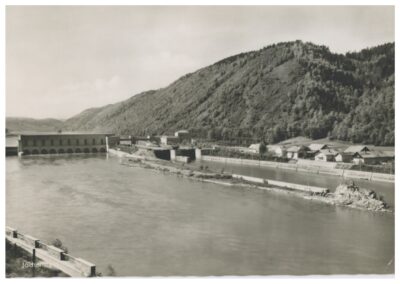Jochenstein Danube Power Plant (DKJ)
At almost 3,000 km, the Danube is the longest river in Central Europe. After joining the Inn and Ilz rivers in Passau, it forms the national border for a length of around 20 km.

Based on a government agreement between the Federal Republic of Germany, the Republic of Austria, and the Free State of Bavaria, Donaukraftwerk Jochenstein AG (DKJ) was founded in 1952, and the Jochenstein power plant was built between 1952 and 1956 at Danube km 2203.
Up to this point, the Danube has a catchment area of 77,000 km, an average water flow of 1420 m³/s, and a maximum recorded water flow of 9200 m³/s (flood in 1954). With an upper water level of 290.00 m above sea level, the drop height at mean water level is 9 m.
DKJ is a stock corporation under German law with a branch office in Austria. Its shareholders are Österreichische Elektrizitätswirtschafts AG (Verbundgesellschaft) with a 50% stake, Rhein-Main-Donau AG with a 49.5% stake, and E.ON Energie AG with a 0.5% stake.
Border power plants (GKW)
Over a length of approximately 100 km from the confluence of the Salzach and Inn rivers to Jochenstein/Engelhartszell, as well as a short stretch in the Kufstein/Kiefersfelden area, the Inn and Danube rivers form the border between the Federal Republic of Germany and Austria. Grenzkraftwerke GmbH (GKW) was founded in 1999 to manage the power plants located along this border section and operates the power plants of Donaukraftwerk Jochenstein AG and Österreichisch-Bayerische Kraftwerke AG (Kraftwerke am Inn).
